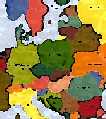 |
Vol 1, No 1, 28 June 1999
|
|
|
 Central Europe Review:
Central Europe Review:Re-Viewing Central Europe By Sean Hanley, Kazi Stastna and Andrew Stroehlein
Today, people still speak of 'Central Europe'; however, they do so, because they sense that countries such as Hungary, the Czech Republic, Poland, Estonia and Slovenia are not properly like the West but are not properly in the post-Communist Wild East either. They are caught between the problems of the post-modern West they are joining and the post-Communist East they seem to be leaving. Do the countries of this new Central Europe need to copy the traditional democratic institutions of the West or join in the debate on 'democratising democracy' already underway there? Do they need to build up effective national states or start dismantling them to fit in with the architecture of the emerging integrated Europe? Can they democratise the police and security services and join in a Europe-wide fight against organised crime? Should they build up public service broadcasting for the sake of civil society or opt for media deregulation and competition like many EU countries? And what about the impact of the consumer culture that means more to many Europeans, West and East, than any number of civic and political ideals? Or the role of the nouveaux riches? Or the position of gay people in society? Too much writing on the region has avoided such questions or missed them altogether. There are now, of course, a host of on-line and other media on Central and Eastern Europe which present the region as emerging markets and investment opportunities. But coverage of broader social, political and cultural trends in the region has been both lagging and lacking. There has been little beyond the week-to-week reporting of the expatriate English-language press and the academically-inclined analyses of specialist publications. Too much writing on the region has - consciously or unconsciously - clung to an outdated image of 'Eastern Europe', desperately trying to patch together political and social developments from Budapest to Bukhara or Tallinn to Tashkent without acknowledging that this Cold War frame of reference is coming apart at the seams. Too much has simply been an exercise in West looking in at East, accompanied by a ritual handing out of brownie points for democracy and civil society. Too much 'analysis' of East and Central Europe has in reality been a disguised debate about how the West can 'manage' the region, which is, as the economist Robert Skidelsky noted, the West's own 'Near Abroad' - a somewhat unwelcome, long-lost relative. The national media in Central Europe, by contrast, have often remained avowedly self-absorbed, provincial and often petulantly nationalist in tone. Everyone is, of course, still more or less in favour of integration with Western Europe. But no one wants to think through the consequences. Journalists across the region routinely cite example from 'civilised countries', but have no real understanding of them. Sadly, this outlook has also coloured much of the national intellectual debate across the region: too many Central European intellectuals and thinkers have either ignored ideas and influences from the wider world or defensively tried fit them into traditional mosaics of thought. In the area of culture, the ground thus far covered by the available media has also been patchy. Central European artists occasionally crop up, and some, such as the Czech musician Iva Bittova, even become flavours of the month in the West. But they are rarely followed comprehensively and comparatively. Within Central Europe itself, there is little interest in any type of Central European cultural space - little desire for national scenes to look at each other. Both artists and audience seem to be largely geared toward the West, while they remain locked in certain rigid national conventions and myths. In many countries of the region, a rather stagnant cultural environment prevails and is dominated by old, unreformed structures, stale retro trends or copycat ventures. There is little in the way of daring innovation and experimentation. Within this general hum of mediocrity, however, there are artists, authors and musicians frustrated with the provincial attitudes and insular cliquey tendencies of their local arts scenes. Some of these artists are part of a new underground which is, ironically, almost as difficult to seek out as in the days of totalitarianism. These days, the underground is truly under ground and composed of people who assume a critical stance to the new status quo and hence are often marginalised and lumped under the derisive moniker of 'radical' outsiders. The aim of CER's culture section will be to seek out some of these artists and their works and, without tending toward over-arching cultural theories, to explore the region's cultural landscape - more specifically the substratum of this landscape that often doesn't make it into the usual scattered array of Central European anthologies and fleeting glances at the region. To feel out and anticipate the current cultural pulse. As in the other sections of CER, the aim will be fluid dialogue rather than rigid structure. At Central Europe Review we will endeavour to highlight new trends and new thinking in and about Central Europe, bridging the gaps and breaking down the impasses in existing coverage. We have neither ready-made answers nor a ready-made agenda. We do not know what the new Central Europe will look like. But we do know that it is already leaving behind many other people's ideas of what it should be. Sean Hanley, Andrew Stroehlein and Kazi Stastna, 28 June 1999
|
|
![]()
Copyright (c) 1999 - Central Europe Review and Internet servis, a.s.
All Rights Reserved